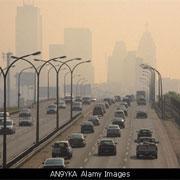 Poor air quality can lead to spikes in heart problems.Alamy
Poor air quality can lead to spikes in heart problems.AlamyStudy after study has shown a connection between smoggy days and an increase in deaths.Now two experiments, one on mice and the other in men, clarify why. Diesel fumes, they find, encourage blood clots that can bring on heart attacks and strokes.
The study in people helps to prove the correlation between heart problems and a city's poor air quality and hints at the role of clotting in this process. And the work in mice exposed to smog suggests that the immune system kick-starts the process.
Together, the two call attention to the dangers of air pollution for people with heart trouble. "The message we're trying to promote is please exercise, it's good for your heart and your health. But if it's a bad [air] day you should think twice," says David Newby, a cardiologist at the University of Edinburgh, UK, who led the clinical study.
Proof Positive
Up to 800,000 people around the world died from causes attributable to air pollution in 2000 alone, according to the World Health Organization — many through heart attacks and stroke.
To add experiment to observation, Newby's team recruited 20 men who had previously had a heart attack. The team exposed half the patients to diesel exhaust made by a Volvo tractor engine — about equivalent to a smoggy day in London — while closely monitoring their condition.
After 2 spells of 15-minutes on an exercise bike, the patients who inhaled the small amounts of soot showed the strain. Less blood made it to the muscular tissue of their heart, and levels of a protein called tPA, which responds to blood clots, were lowered. After the experiment, these factors returned to normal.
"This sort of back-up mechanism [to clotting] is lost when you're exposed to diesel, and therefore it makes a clot form a lot more likely to be successful and a heart attack to occur," says Newby, whose team reports the findings in the New England Journal of Medicine1.
Clot Away
Previous work in hamsters identified excessive blood clotting, or thrombosis, as a culprit. Now a study in mice shows how this happens.
Gökhan Mutlu, a physician at Northwestern University's Feinberg School of Medicine in Chicago, and his colleagues were studying the effects of air pollution in mice when they noticed that animals exposed to dirty air didn't bleed for as long as mice that breathed clean air. The fume-inhaling mice showed higher levels of several proteins linked to blood clotting.
ADVERTISEMENT
When Mutlu's team eliminated immune cells that are likely to mop up soot particles from the lungs of mice, no clotting problems occurred. The same thing happened in mice that were missing a gene for an immune signalling protein called interleukin-6.
The results suggest that it is the immune response to particles in the lungs that causes inflammation and leads to clots, they report in the Journal of Clinical Investigation2.
"These two studies are pretty nicely complementary," says Mutlu, referring to his work and Newby's clinical study.
Cleaner Air
The two studies are convincing, but there could be other explanations for how air pollution causes heart attacks, says Benoit Nemery, a toxicologist at the Catholic University of Leuven, Belgium. He has shown that tiny soot particles enter the bloodstream where they may affect the heart directly, rather than via an immune response in the lung.
Nemery agrees that people with heart problems shouldn't run marathons when the air is poor, but he sees a better solution than stopping the exercise: "I don't think you should blame the victims — that they should change they their way of life. What we should aim for is to make the pollution go down."
Visit our inifyourehavingabad.html">newsblog to read and post comments about this story.
